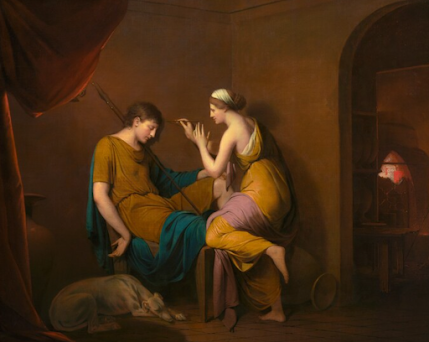The Influence of the Middle Class - A Classical Blog Exhibit
The Middle Class
Starting in the early 1700's the rise of the middle class began. Trades men and women, merchants, artisans, and so many more people were realized to be major contributors to society that everyone knew, and it began to be reflected in art pieces all over the world. People were usually ranked into social classes depending on how much money they made or what their family ties were, but in the 1700's the tides began to change, and people were valued more and more for what skills they had and for what trades or professions they had and what they could do for those around them.
This piece really stood out to me because of the ambient lighting shown onto the two subjects and when I first looked at this painting, I did not know what they were doing, but one of my sources explains it well "The girl was the daughter of a potter in Corinth. Her boyfriend was about to embark on a perilous journey to foreign lands, taking only his spear and dog. As a memento, she traced her sleeping lover’s silhouette onto the wall. Her father then used the drawing to model a clay relief, which he baked in his kiln to create a ceramic keepsake."(National). When learning what she was doing I was amazed and thought how greatly this represents the middle class and how hard they work for those they love and the sacrifices they make to take care of their families. I really enjoy the richness of the yellow, blue, and pink shades in the two subjects clothing and the folds and textures shown in their clothing and the dog's sleek fur and physique is clearly shown with the strokes of the paint. I also really love the elements discussed in my source material "Joseph Wright, a master of artificial illumination, concealed a hanging lamp behind the curtain, suggesting the source of the beams that cast the youth’s shadow. In contrast to the lamp’s gentle glow, intense sparks and embers leap inside the potter’s fiery furnace."(National)
Angelica Kauffman - Mother of the Gracchi, Pointing to her Children as Her Treasures 1785
This beautiful piece with rich colors and imagery of shadows and depth is amazing and the title itself really made me think of the middle class during this time period. The way the mother views her children as her treasures speaks volumes as to what the middle class valued and wanted for themselves and their family. Most people think of gold, jewelry, housing, etc. as treasures but, this mom saw her children as the prize. One of my sources states it well "The scene that we see in Kauffmann’s painting illustrates one such example of Cornelia’s teachings. A visitor has come to her home to show off a wonderful array of jewelry and precious gems, what one might call treasures. To her visitor’s chagrin, when she asks Cornelia to reveal her treasures she humbly brings her children forward, instead of running to get her own jewelry box. The message is clear; the most precious treasures of any woman are not material possessions, but the children who are our future. You can almost feel the embarrassment when you look at the face of the visitor, who Kauffmann has smartly painted with a furrowed brow and slightly gaped mouth." (Dana Martin)
Giacomo Francesco Cipper - A Spinner 1700 - 1730 - Oil on canvas
Works Cited
National Gallery of Art. British and American History Paintings of the 1700s, https://www.nga.gov/features/slideshows/british-and-american-history-paintings-of-the-1700s.html#slide_9.
Museo Nacional del Prado. “A Spinner - the Collection.” The Collection - Museo Nacional Del Prado, 1 Jan. 1730, https://www.museodelprado.es/en/the-collection/art-work/a-spinner/5205b2e6-ef44-4fab-b651-48c777e802a6.





Comments
Post a Comment